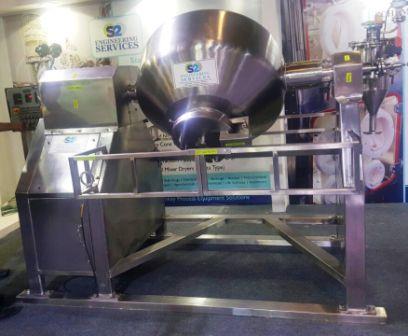
Process drying is an important operation for many products across many industrial sectors. Essentially drying removes mositure from a product, so that it can be further processed. Pharmaceutical tablet manufacturing is a typical example of where drying operations are conducted (upstream of the tablet press).
The two principal types of vacuum dryers are tumble and agitated as discussed previously. Determining which vacuum dryer is best for your application depends in part on knowing your material's moisture content. But you also need to understand the material's particle characteristics because these characteristics at different moisture levels can vary in unexpected ways. For instance, a filter cake containing 40 percent moisture can flow better than one with 15 percent moisture. For this reason dryer manufacturers such as S2 Engineering may want to test the clients material before determining which dryer will best handle it.
The tumble vacuum dryer consists of a rotating or tumbling vessel, most commonly in a double-cone shape. By controlling atmospheric pressure, the vacuum dryer increases the effective ΔT for a given process.
A thermal jacket encloses the entire vessel; the vessel is supported by two trunnions. A small, stationary vacuum line in one trunnion extends into the vessel; a small vacuum filter is located at the line's inlet. A delumping bar can be mounted on one trunnion and extend into the drying chamber.
In operation, the vessel rotates about the trunnions' axis. The integrity of the seal around the stationary vacuum line - which extends through the trunnion and is angled upward into the drying chamber's top, above the material in the rotating vessel - is critical for maintaining the dryer's vacuum. During rotation, the material cascades inside the chamber, gently tumbling and folding to bring the material into contact with the heated walls. This action makes the dryer especially suitable for handling friable and fragile materials that can't withstand shear from agitation, such as polyethylene terephthalate pellets. The delumping bar can be operated intermittently to break up undesired agglomerates.
The agitated vacuum dryer consists of a stationary cylindrical or trough-shaped vessel that has a rotating shaft mounted with agitators of various configurations. The dryer can handle wetter materials and less free-flowing materials than the tumble dryer.
The dryer's agitator configurations are based on various blender designs, including ribbon, paddle, and plow mixers. In some models, the rotating shaft and agitators can also be heated with hot media. A large vacuum line is connected to a large jacketed vacuum filter housing at he dryer vessel's top.
Your material's particle characteristics at different moisture levels can vary in unexpected ways.
In operation, the material is blended as the shaft-mounted agitators rotate and move the material into contact with the dryer's heated walls (and, in some cases, the heated shaft and agitators). The agitation permits the dryer to handle materials approaching slurry consistency or sticky materials with high viscosity. Examples include various clays, aluminum pastes, and other metal pastes.
How they compare. Both tumble and agitated dryers are easy to load. However, discharge and cleaning are much easier in the tumble dryer because it has no internal shaft or agitators. The tumble dryer also has a significantly lower capital cost than the agitated dryer.
Agitated dryers provide greater efficiency than the tumble dryer by providing a higher overall heat transfer coefficient (U), allowing better heat transfer to the material. The agitated unit also provides greater effective heat transfer surface area (A) than the tumble dryer, resulting in a better heated-surface-to-volume ratio for drying.
The agitated unit's larger vacuum line and larger filter area (in the jacketed vacuum filter housing) also provide a vapor-flow advantage for an application where the vaporization of unbound moisture is especially fast during constant-rate drying. Removed moisture is such a case can sometimes bottleneck in the tumble dryer's smaller through-the-trunnion vacuum line and smaller filter area.
The agitated dryer's stationary vessel also allows hard piping and fixed connections that aren't possible with the tumble dryer, which simplifies installation and maintenance.
S2 Engineering manufacture both types of vacuum dryers. See Rotary Cone Vacuum Dryers (RCVD) and Rotary Vacuum Paddle Dryers (RVPD) or for further information please contact the S2 Engineering Technical Team.


